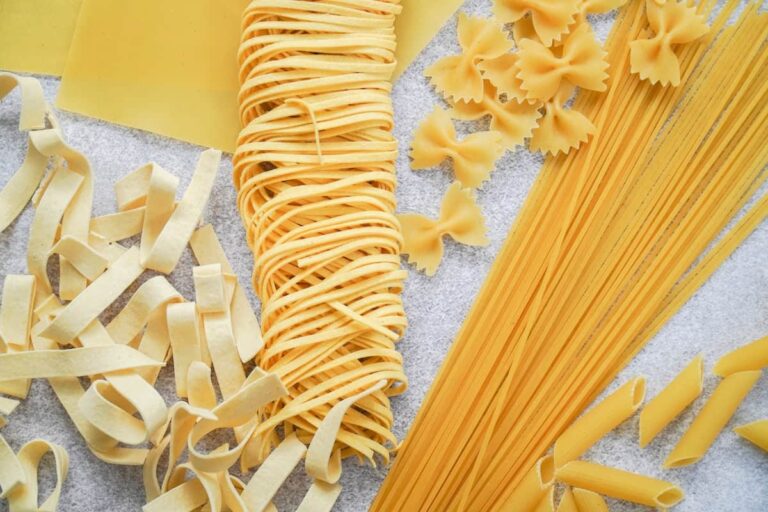Regarding popular comfort foods, noodles and pasta are two of the most common options. Although these two dishes share some similarities, they also have several differences that set them apart.
This article will explore the key differences between noodles and pasta and help you understand which dish is perfect for your next meal. So, whether you’re a die-hard pasta fan or a noodle enthusiast, read on to learn more about these classic favorites.
What are Noodles
Noodles are made from unleavened dough, usually made from wheat flour, water, and eggs, that is stretched, rolled, and cut into different shapes and sizes.
They are a staple in many Asian cuisines, such as Chinese, Japanese, and Korean, and are served in soups, stir-fries, or as a side dish.
What are Pasta
Pasta is a type of food made from a mixture of flour, water, and sometimes eggs that is kneaded into a dough and then rolled out and cut into different shapes.
It is a staple in Italian cuisine served with sauces, such as tomato sauce, pesto, or alfredo sauce, and can also be used in salads, soups, and casseroles.
Similarities Between Noodles And Pasta
Cooking Method:
There are similarities in the cooking method between noodles and pasta.
- Both require a large pot of boiling, salted water to cook properly.
- The cooking time for both also varies depending on the shape and thickness of the noodle or pasta.
- It is important to cook them until they are al dente, which means to cook through but still firm when bitten.
- Noodles used in Asian cuisine are often boiled separately and then added to a soup or stir-fry, while the pasta is usually boiled in the same pot as the sauce and then served together.
- Additionally, the cooking time for noodles is usually shorter than pasta, as they are thinner and more delicate.
Texture and shape:
The texture and shape of noodles and pasta can vary depending on the recipe, but there are some general differences between the two.
Noodles are typically thinner and more delicate than pasta and can have a softer texture. They are often long and thin, such as spaghetti or vermicelli, or flat, like fettuccine or udon.
Pasta, on the other hand, can be thicker and more substantial than noodles, with a chewier texture. It comes in a wide range of shapes, including spaghetti, penne, macaroni, and lasagna.
Additionally, pasta can be fresh or dried, with fresh pasta having a softer texture and more delicate flavor than dried pasta.
Read Also:
Culinary uses:
Noodles and pasta have different culinary uses due to their distinct textures and shapes. Noodles, particularly those found in Asian cuisine, are often used in soups, stir-fries, and as a side dish. They can be served hot or cold, and their delicate texture makes them perfect for absorbing the flavors of the dish they ladle out.
On the other hand, pasta, especially in Italian cuisine, is usually served with sauce, such as tomato sauce, pesto, or alfredo sauce. The various forms of pasta, such as spaghetti, penne, and lasagna, are designed to hold onto the sauce, making each bite flavorful.
Which Is Healthier: Noodles Or Pasta?
When it comes to determining which is healthier, pasta and noodles, it is important to consider the ingredients and nutritional value of each dish.
Generally speaking, noodles are often considered the healthier option due to their lower calorie and carbohydrate count.
Noodles are typically made from wheat flour, water, and eggs and are lower in calories and carbohydrates than pasta, which is made from a mixture of flour, water, and sometimes eggs. Noodles also contain fewer calories and carbohydrates than pasta per serving, making them a better option for those watching their weight or trying to stay within certain dietary guidelines.
However, it is worth noting that the type of pasta or noodles you choose can impact its nutritional value. For example, whole wheat pasta is a healthier option than traditional pasta, as it is higher in fiber and lower in calories. Similarly, some types of noodles, such as soba noodles made from buckwheat flour, are considered healthier due to their higher protein and fiber content.
Ultimately, when it comes to determining which is healthier, pasta and noodles, it is important to consider the specific dish and ingredients used, as well as any dietary restrictions or preferences.
Do pasta and noodles taste the same?
The taste of pasta and noodles can differ based on the ingredients and cooking methods. However, the flavor of both dishes can be enhanced by the sauces and seasonings used to accompany them. Ultimately, it depends on personal preference and the specific recipe being prepared.
Ingredients Used
Noodles are made by mixing wheat flour, water, and eggs to create an unleavened dough. However, in some instances, other ingredients such as rice flour, tapioca starch, or potato starch can be used as substitutes for wheat flour.
While pasta is made from a mixture of flour, water, and sometimes eggs, the most common types of flour used for pasta are semolina flour and durum wheat flour. However, other types of flour, like all-purpose flour, can be used. Depending on the recipe, pasta can also include other ingredients like olive oil or salt.
Additionally, noodles and pasta are widely available in grocery stores and are relatively inexpensive, making them accessible to people of all backgrounds.
Finally, both dishes have a long history and cultural significance in their respective cuisines, making them part of many people’s culinary traditions.
Conclusion:
In conclusion, noodles and pasta are two popular comfort foods that share some similarities but also have differences that set them apart. However, both can be cooked in boiling water and served hot or cold, making them versatile ingredients in different dishes.
Ultimately, whether you prefer noodles or pasta, it’s clear that both have a long history and cultural significance in their respective cuisines and are enjoyed by people all over the world.



